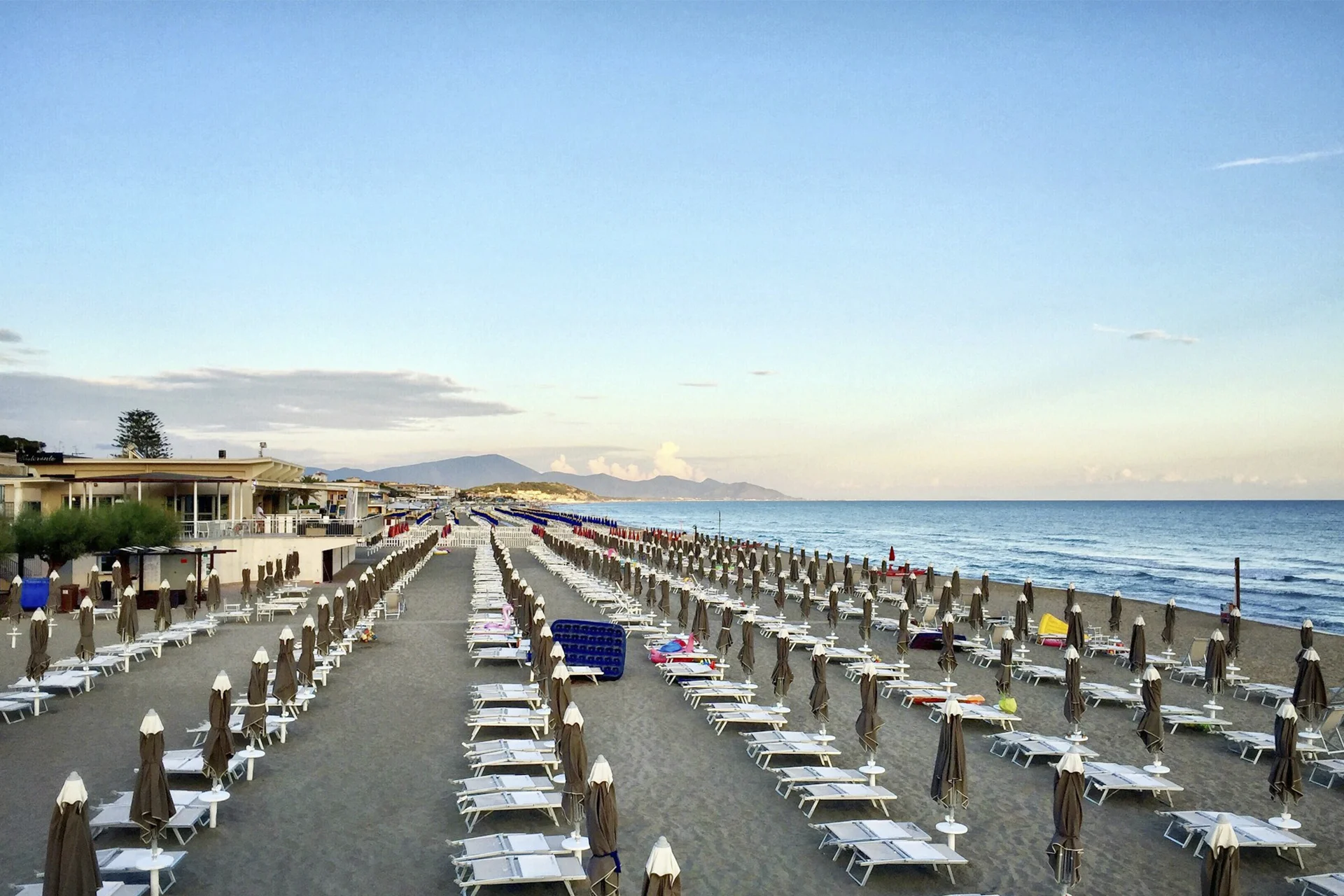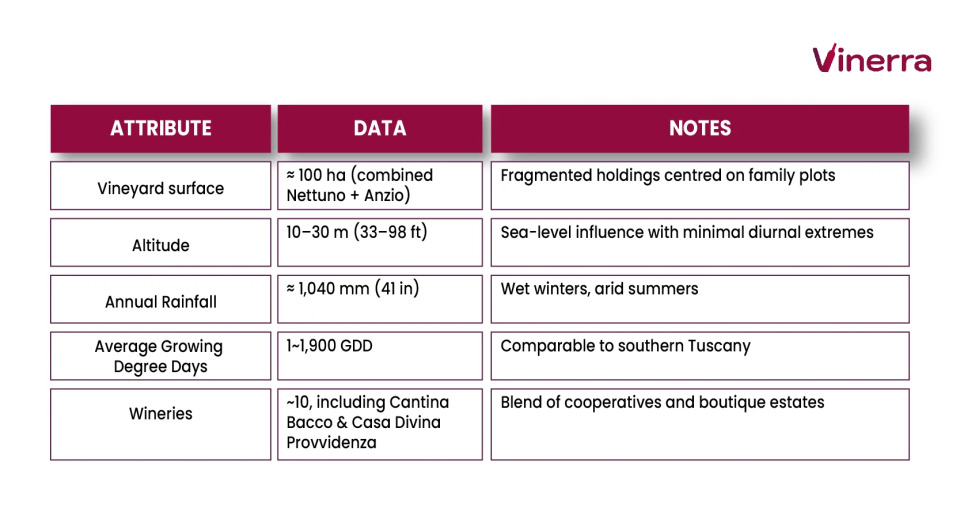
LATITUDE
LONGITUDE
APPELATIONS
Think of Nettuno DOC as the wine region that time forgot... until it didn’t.
While Tuscany was busy with its Renaissance, and Piedmont perfected Nebbiolo, this coastal strip south of Rome quietly preserved Roman-era grape varieties in good volcanic soils. The well-drained soils ensure good soil moisture from rainfall, which is beneficial for vine health.
In 2003, official DOC recognition finally arrived, validating what locals had known for millennia: the combination of Mediterranean breezes, ancient Macco limestone, and indigenous Bellone grapes creates wines that taste like liquid sunshine with a mineral backbone.
About 60 kilometres south of Rome, Nettuno DOC sits on Lazio’s sunlit Tyrrhenian coast. The appellation includes the communes of Nettuno and Anzio, ancient towns whose vineyards once supplied Roman emperors. Nettuno DOC has a relatively small vineyard area of approximately 12 hectares as of 2021.
Coastal winds cool the vines by day and protect them from humid nights, making high-quality wines by enhancing air circulation, moderating temperatures, and reducing disease pressure. This results in wines that are aromatic yet fresh. Unlike neighbouring Castelli Romani, Nettuno remains rooted in local grapes—particularly Bellone (Cacchione), a variety so ancient that Pliny the Elder called it “uva pantastica.”
This italian DOC produces white, red, rosé, and lightly sparkling wines. Bellone-based whites dominate production, prized for their balance of saline minerality and ripe Mediterranean fruit.

These mild conditions, along with excellent drainage on Macco limestone, give Nettuno consistent, Mediterranean ripening while protecting acidity.
In the first century BCE, Antium—modern Nettuno and Anzio—was celebrated as a Roman resort and agricultural hub. Amphora shards unearthed in the Astura Valley reveal continuous wine production since antiquity. The Bellone grape likely originated here, thriving in porous coastal soils and used in wines exported to Rome.
Viticulture endured through medieval abbeys and Renaissance estates. World War II brought devastation—Anzio’s 1944 Allied landings left vineyards scarred, but recovery followed. In 1973, farmers united under Cantina Bacco, rebuilding the region’s reputation by focusing on traditional grapes.
By 2003, the Ministry of Agriculture officially recognized Nettuno as a DOC, enshrining centuries of winemaking know-how. Today, a variety of wines are produced in the Nettuno DOC zone, including white, red, and rosé wines, reflecting the prodigious efforts of local producers. Wines from Nettuno DOC have not significantly influenced wine history, but they remain a testament to the region’s dedication to preserving its unique viticultural heritage.

Vineyard Hectares
WINERIES
GROWING DEGREE DAYS
Nettuno DOC lies along the Tyrrhenian coast in southern Lazio, roughly 60 kilometres south of Rome, and encompasses the communes of Nettuno and Anzio. This seaside zone benefits from its gentle slopes and proximity to the sea, where vineyards stretch toward sandy coastal plains framed by river valleys. The ocean’s influence defines this geography: balancing intense Mediterranean light with soft breezes that cool the vines and preserve delicate aromas. The landscape of the Lazio wine region includes a mix of volcanic hills, peaceful lakes, and rolling plains, adding to its scenic beauty and agricultural diversity.
The climate is distinctly Mediterranean, influenced by the Tyrrhenian Sea. Hot, dry summers and mild, rainy winters maintain a steady balance between vine growth and ripening. Average summertime temperatures hover near 25 °C, tempered by constant sea winds that reduce disease pressure and maintain acidity. The Tyrrhenian Sea provides a cooling effect on hot summer days. Rainfall concentrates in autumn and early winter, replenishing soils while leaving the growing season largely dry: conditions suitable for grapes like Bellone and Trebbiano Toscano.
The defining geological feature is Macco, a Pliocene-era calcareous sandstone found across Nettuno and Anzio. This fossil-rich stone, interlaid with volcanic ash and sandy deposits, gives the wines their hallmark saline minerality. Macco’s firm yet porous structure drains efficiently and stores minerals deep in its layers, allowing the vines to thrive in stress conditions and craft wines that taste vividly of sea air and stone.
Lazio has volcanic origins, with ancient volcanic hills like the Colli Albani contributing to the region's diverse terroir. However, the unique soil of the Nettuno DOC is primarily siliceous, derived from a former seabed, and thus provides less mineral richness than volcanic soils.
The producers from this DOC work with different grape types, each suited to the local coastal climate. The key grapes of Nettuno are Bellone, Trebbiano Toscano, Merlot, and Sangiovese.
WIthin the Nettuno DOC the signature wines are Nettuno Bianco, Nettuno Bellone, Rosso, Rosato and Novello (a red wine released early than Rosso).

Both Bianco and Bellone Frizzante highlight the region’s affinity for fresh, slightly sparkling wines ideal for seafood culture.
Nettuno’s pairing rule is simple: what swims nearby pairs well with your wine. Each of these wines has great versatility to be paired with different local dishes:
Even vegetarian fare shines: Bellone’s slight bitterness complements artichoke dishes that many wines struggle with.
Skip Tuscany’s crowds and head to the Anzio–Nettuno Riviera, where beaches meet vineyard rows. Cantina Bacco, a cooperative of over 100 families, anchors the local tasting circuit. Visitors tour underground Macco caves once used for cellaring and sample their signature Pantastico Cacchione, a textural white evoking Mediterranean honey and sea wind.
Nearby, Casa Divina Provvidenza, founded in 1890, demonstrates the continuity of vineyard cultivation across three generations. It offers tours through 60 hectares bordering the Astura River, with the Macco bedrock visible beneath the vines.
Beyond the cellar, Nettuno charms with its fortified Borgo Medievale, Forte Sangallo, seafood taverns overlooking the marina, and the solemn American Cemetery of WWII’s Anzio landing. The vibe: Roman seaside leisure with deeper roots, ideal for visitors seeking authenticity over opulence.
If you are eager to drink locally grown wines, Cantina Bacco and Casa Divina Provvidenza are the best exponents you will find within Nettuno:
Together, these estates anchor Nettuno’s modern Renaissance: proof that sustainable, small-scale viticulture can advance regional identity.
Nettuno’s sustainability is more than marketing; it’s survival. With tiny holdings and thin soils, growers naturally avoid excess inputs. Bellone’s drought resistance means reduced irrigation; constant breezes diminish disease risk, reducing the need for chemical treatments.
Producers increasingly turn organic and embrace short supply chains, selling directly through agriturismi and local markets. Lazio’s regional initiatives fund integrated pest management and solar energy adoption across small cooperatives. The result? Lower emissions, higher soil vitality, and wines truer to place.
Yet challenges remain: younger generations migrating to cities, rising land costs, and competing narratives from larger DOCs. The opportunity lies in storytelling—anchoring Nettuno wines to their dual allure of Roman authenticity and coastal freshness. Media coverage and awareness campaigns have also played a key role in highlighting Nettuno DOC's sustainability initiatives and promoting the region's wines.